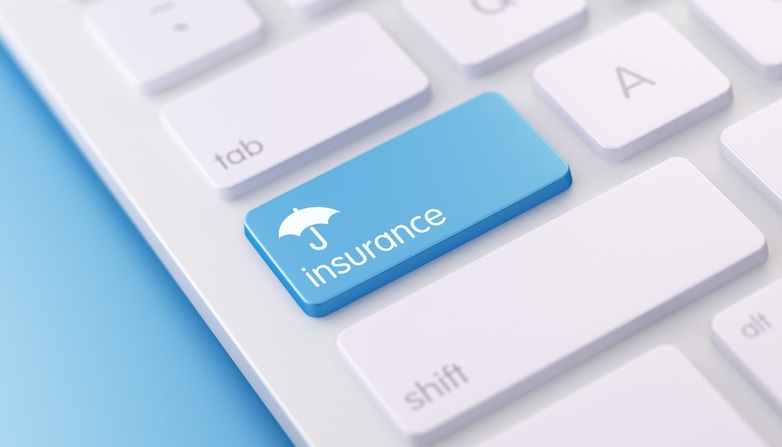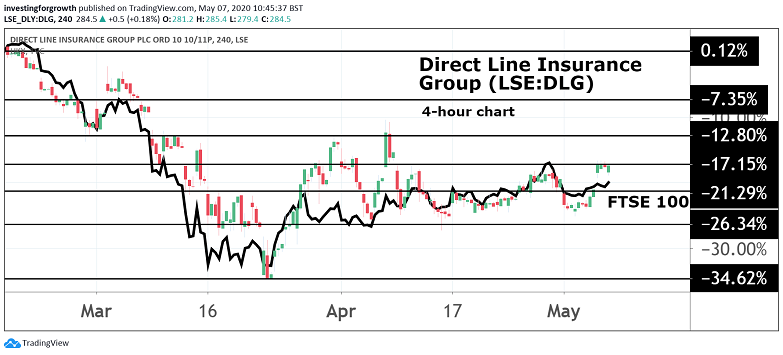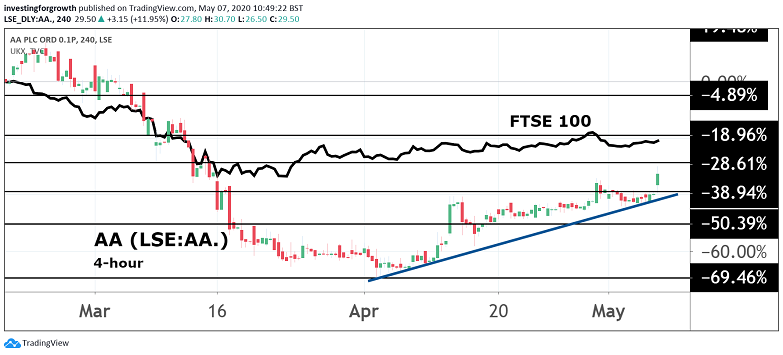Stockwatch: two insurance shares I’d buy
After running through results for these two household names, our companies analyst is optimistic.
7th May 2020 11:06
by Edmond Jackson from interactive investor
After running through results for these two household names, our companies analyst is optimistic.

Do insurance companies merit higher ratings while Covid-19 persists to any degree? For those well-capitalised, a combination of lower claims and relatively strong dividend paying capability once April’s regulatory restrictions ease, could tilt risk/reward in their favour.
The question struck me on considering yesterday’s update from £3.7 billion Direct Line Group (LSE:DLG) that helped its shares rise nearly 5% to 284p yesterday, which is in between last February’s 345p high and its March 227p low. Also, the heavily-indebted roadside recovery giant AA (LSE:AA.) – now worth just £160 million – has published prelims today.
- Invest with ii: Top UK Shares | Share Tips & Ideas | Open a Trading Account
Direct Line has had a strong reputation for yield, having grown its dividend from about 14p to 21p a share in recent years (see table), and with 22p and 24p targeted for 2020/21 until the virus struck. However, this reflects a large mature business where shareholders have had to endure a volatile-sideways stock trend in the last four years, somewhat declining from about 360p in the last two.

Source: TradingView. Past performance is not a guide to future performance.
The table shows robust cash generation versus modest capital expenditure – hardly as if Direct Line is going to re-invent itself – hence free cash flow numbers are pretty much the same as earnings.
For better or worse, 'return of capital' is also being pursued with share buybacks. Such a lack of obvious capital growth appeal means the stock gets priced for yield to attract income-seekers who still face the dilemma about whether more attention should be paid to overall investment criteria.
| Direct Line Insurance Group - financial summary | ||||||
|---|---|---|---|---|---|---|
| year end 31 Dec | 2014 | 2015 | 2016 | 2017 | 2018 | 2019 |
| Turnover (£ million) | 3,349 | 3,253 | 3,321 | 3,496 | 3,427 | 3,300 |
| Operating margin (%) | 13.6 | 15.6 | 10.4 | 15.2 | 16.8 | 15.3 |
| Operating profit (£m) | 457 | 508 | 345 | 531 | 577 | 506.0 |
| Net profit (£m) | 373 | 588 | 279 | 434 | 472 | 420 |
| EPS - reported (p) | 26.0 | 28.1 | 20.2 | 31.5 | 32.9 | 29.2 |
| EPS - normalised (p) | 26.7 | 27.0 | 23.2 | 32.9 | 32.9 | 29.9 |
| Price/earnings ratio (x) | 9.1 | |||||
| Operating cashflow/share (p) | 51.4 | 37.6 | 62.4 | 39.6 | 35.6 | 33.4 |
| Capital expenditure/share (p) | 13.9 | 9.9 | 9.5 | 6.9 | 11.3 | 13.6 |
| Free cashflow/share (p) | 52.9 | 32.7 | 24.3 | 19.9 | ||
| Dividends per share (p) | 14.4 | 13.8 | 14.6 | 20.4 | 21.0 | 7.2 |
| Yield (%) | 4.1 | |||||
| Covered by earnings (x) | 1.8 | 2.0 | 1.4 | 1.5 | 1.6 | 4.0 |
| Cash (£m) | 880 | 964 | 1,166 | 1,359 | 1,154 | 949 |
| Net debt (£m) | -284 | -381 | -571 | -523 | -319 | -126 |
| Net assets (£m) | 2,811 | 2,630 | 2,522 | 2,702 | 2,558 | 2,644 |
| Net assets per share (p) | 205 | 191 | 185 | 199 | 188 | 193 |
| Source: historic Company REFS and company accounts |
Covid-19 does not offer a radical reset, but might it at least tilt matters more positively? A fundamental driver would be lower motor claims as people drive less and technical support for the likes of Direct Line shares as other industries’ dividends get compromised – possibly for years.
Assuming the current regulatory constraint on insurance company dividends lifts, which I think it will.
Strong solvency argues for dividend restoration
An end-March diktat from the Prudential Regulation Authority thwarted Direct Line’s 14.4p final dividend – that otherwise would have taken payouts in respect of 2019 to 21.6p.
Pre-lockdown, this had been projected to expand to 22.5p then 24.1p in respect of 2020 for a yield of over 8%, hence it being pertinent to consider what fundamentals of the industry may support future dividends. The board intends to review the payout this summer at around the time of the interim results, and on an ongoing basis, once it is possible to have a better understanding of the impacts of Covid-19.
In its favour, Direct Line has strong solvency – the ratio of net assets to net premium written – where 176% at end-March was at the top of its 140-180% target range. If the final dividend had been paid, this would have taken solvency to 161% as if ample capability on fundamentals. So, if a reasonably favourable trend of premiums written versus claims can persist, Direct Line is potentially distinguished for income.
For the first quarter of 2020, a net 25 million travel claims were offset by a reduction in claims generally across the group, down 70% in motor as people stayed home. Gross written premiums rose 4.7% to £789.6 million with own brands growth of 5.6%.
Motor did best, up 6.2% to £410.9 million, but has slowed since the virus restrictions were introduced, if partly reflecting a brief suspension of phone sales.
- A checklist for finding dividend shares in a crisis
- James Mee interview: dividend strategy and favourite stocks
- Will the other top UK dividend payers follow Shell's lead?
- Take control of your retirement planning with our award-winning, low-cost Self-Invested Personal Pension (SIPP)
I would mind a risk of cars being declared off-road and possibly younger/unemployed people giving up driving if the pandemic drags on, although the net effect would include lower claims if there are fewer events to drive to, and more people working from home.
Costs of £70 million are being incurred for a range of measures, including to support customers in financial difficulties, pause redundancies until at least the autumn, and provide NHS workers with free breakdown services.
These look transitory rather than enduring, and, for context, the 2019 income statement showed £705 million operating expenses (also £212 million commission expenses) whittling pre-tax profit down to £510 million versus £581 million in 2018, albeit with costs remaining similar.
So, the £70 million costs might add about 8%. Direct Line has not had to furlough employees; the vast majority are working from home on regular pay, so substantive redundancy costs are not in the offing.
Historically, the table shows good operating margins of over 15%, and there is a similar return on equity. We just need a sense of whether premiums written versus claims are sustainably favourable in the new environment. My belief is that any erosion of premiums from reduced car ownership and travel will be offset by reduced claims. Arguably, more people working from home should mitigate burglaries, for example.
So, it is somewhat speculative as yet, but I feel I should flag a sense for Direct Line as a Buy.
AA recovery continues albeit some fresh uncertainties
AA shares initially jumped from about 26.5p to over 30p on its prelim results to end-January, probably because expectations adjusted after a 31 March update said Covid-19 had not impacted the group but that risks remain, including of disruptions. The price then settled back to 28.5p as if the message is “good in parts” – which is a fair summation – but has regained 30p as risk-lovers are encouraged.

Source: TradingView. Past performance is not a guide to future performance.
It is a trickier comparison with Direct Line, given roadside assistance constitutes to generate 85% of revenue and 81% of trading EBITDA.
However, growth in the home and motor books drove a 6% increase in revenue, reflecting positively on bread-and-butter policies for the industry. Underwriting revenue jumped 47%, albeit from a low base to £28 million. There’s less information than Direct Line on the net upshot in terms of claims though.
The primer for these results had been ongoing cost-cutting, and how the AA had proved resilient through previous downturns. “The management team has successfully turned the operational and commercial performance of the AA around in the last two years and remains focused on navigating the challenges ahead,” it says.
Today, we learn operating profit is up 17% and pre-tax profit by 102% to £107 million, on revenue up 2% to £995 million – an earnings per share (EPS) of 14.1p gives a snapshot price/earnings (PE) multiple of sub-2x. That’s good in terms of an overall recovery story, but is tempered by £2.6 billion net debt which hasn’t really changed over the year, thus net finance costs swallowed 58% of operating profit.
Remarkably, the board still saw fit to pay a 0.6p interim dividend, though a final payout has been suspended. Perhaps they took heart along the way by free cash flow multiplying seven-fold to £83 million for the year.
Dividend restoration is thus tentative here, and debatable, although the stock is more an option play on whether the business can work off its debt overhang (from a private equity past). Optimists may consider the world is moving towards even lower-cost debt and maybe debt cancellations – the so-called 'jubilee'.
AA’s narrative is tempered because, while February and March went well, from April “we started to see greater variance as a result of Covid-19” – resulting in changes both to roadside and insurance with “material cost reduction programmes to mitigate the significant uncertainty ahead".
Unless Direct Line is being candid until a proper reporting date, and more evidence about how things are playing out, the AA’s message is relatively more uncertain – and costly. At least Direct Line was able to quantify its £70 million and appear to avert anything like a restructuring.
Perhaps the AA’s bias to emergency road services – with free help/repairs to NHS workers and the London Ambulance Service – has upped costs, given it is far more oriented towards vehicle support, but they should ease with the crisis.
There appears to be a headwind by way of new AA memberships slightly down and retentions also marginally lower – albeit total road breakdowns are materially down, while garaging costs are lower but parts/battery sales (cars not being run sufficiently) higher. Driving schools and car hire have suffered, too.
Versus Direct Line, the AA has had to apply for the government furlough scheme, “although the majority of our workforce continues to provide services to our customer".
Short covering may be the key to AA’s current stock trend
AA shares have therefore a more speculative rather than investment interest. In reaction to a steady business recovery, large investors and hedge funds are more likely to buy back shares they had sold in anticipation of the share price falling (short covering, or short closing). Some kind of debt restructuring might also be favourable enough to shareholders.
The proportion of AA’s issued share capital out on loan (to short sellers) has declined from 12.6% in March 2018 to 4.4% currently, though it did run up to 8.9% in the five months to this March-end. By contrast, there are zero disclosures (over 0.5%) of short interest in Direct Line Group. AA’s recent Altman Z2 score of minus 4.0 has indicated a serious risk of financial distress within the next two years, although such ratings can be backward-looking.
A speculative 'buy' case exists in the sense that the policy response to Covid-19 will help quasi-zombie companies, such as AA, to claw back equity value – although that also assumes its roadside services remain competitive.
I will disclose an interest by way of renewing my membership, and I think the AA is pretty much essential. For speculators then, the recovery story is broadly affirmed. Buy.
Edmond Jackson is a freelance contributor and not a direct employee of interactive investor.
These articles are provided for information purposes only. Occasionally, an opinion about whether to buy or sell a specific investment may be provided by third parties. The content is not intended to be a personal recommendation to buy or sell any financial instrument or product, or to adopt any investment strategy as it is not provided based on an assessment of your investing knowledge and experience, your financial situation or your investment objectives. The value of your investments, and the income derived from them, may go down as well as up. You may not get back all the money that you invest. The investments referred to in this article may not be suitable for all investors, and if in doubt, an investor should seek advice from a qualified investment adviser.
Full performance can be found on the company or index summary page on the interactive investor website. Simply click on the company's or index name highlighted in the article.
Disclosure
We use a combination of fundamental and technical analysis in forming our view as to the valuation and prospects of an investment. Where relevant we have set out those particular matters we think are important in the above article, but further detail can be found here.
Please note that our article on this investment should not be considered to be a regular publication.
Details of all recommendations issued by ii during the previous 12-month period can be found here.
ii adheres to a strict code of conduct. Contributors may hold shares or have other interests in companies included in these portfolios, which could create a conflict of interests. Contributors intending to write about any financial instruments in which they have an interest are required to disclose such interest to ii and in the article itself. ii will at all times consider whether such interest impairs the objectivity of the recommendation.
In addition, individuals involved in the production of investment articles are subject to a personal account dealing restriction, which prevents them from placing a transaction in the specified instrument(s) for a period before and for five working days after such publication. This is to avoid personal interests conflicting with the interests of the recipients of those investment articles.